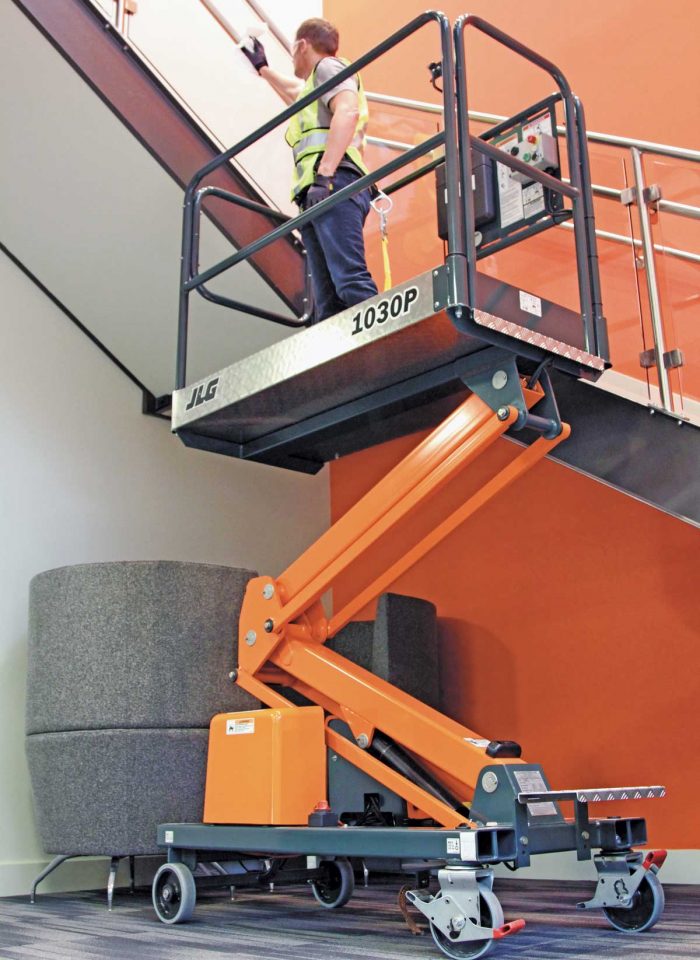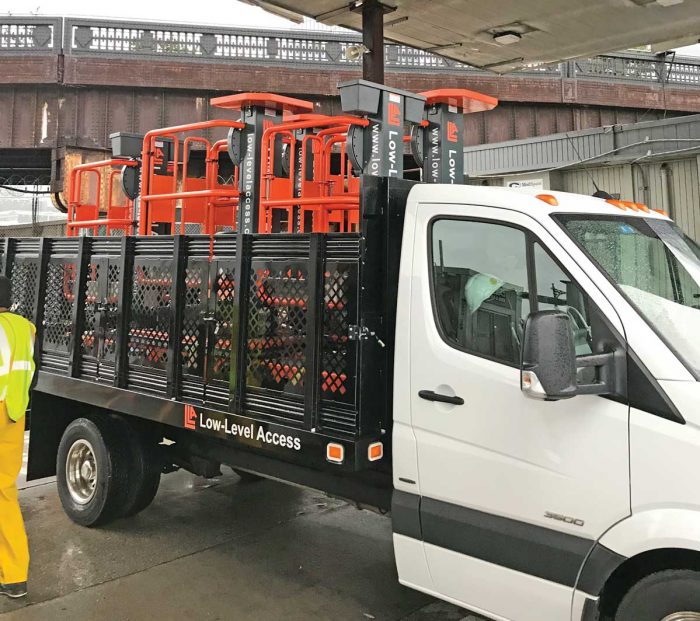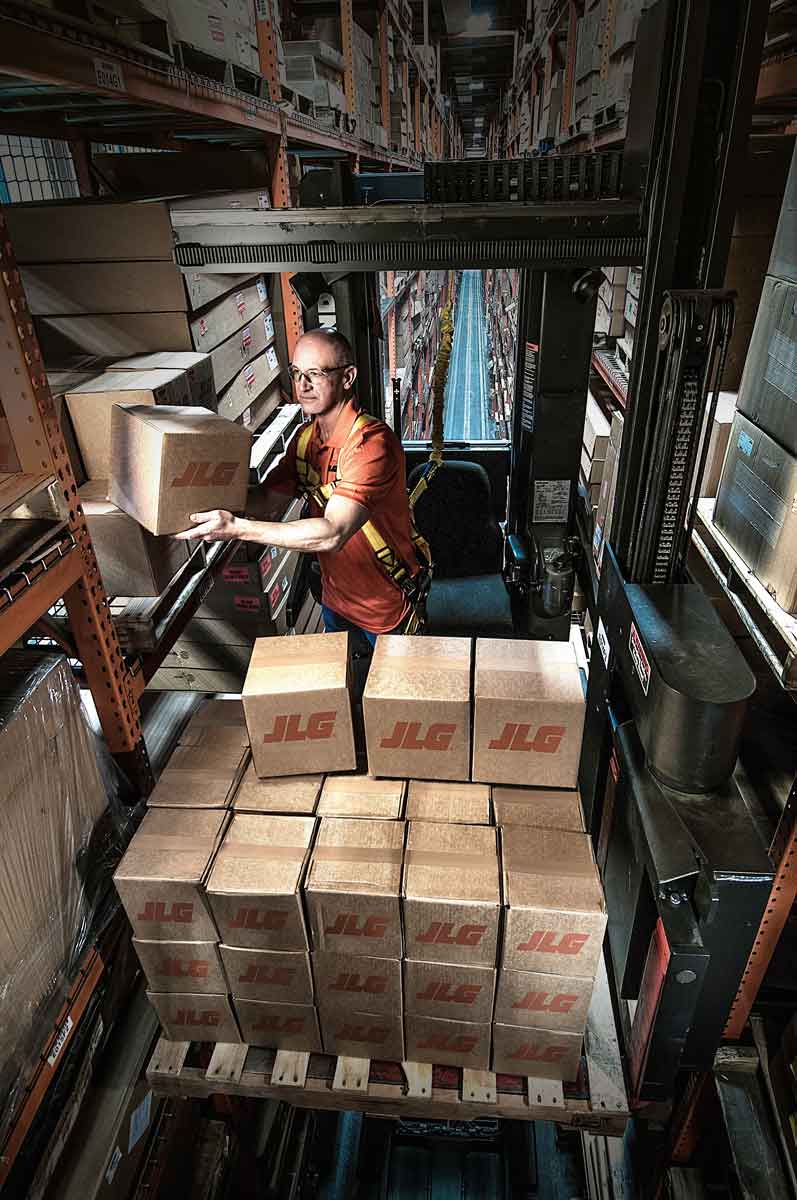Small Spaces, High Places: Micro Elevating Work Platforms Give Easy Access to Even the Most Hard-to-Reach Locations

Getting workers safely to and from elevated work areas has been a problem since the very first human structures were built. And, over the years, as our urban centers have become more densely packed and vertical in composition, this has included the need to reach elevated work areas in highly constricted and confined areas as well. Luckily for contractors faced with such difficulties, new and smaller elevating work platforms are allowing high-reach access to areas with minimum fuss and an emphasis on safety.
Dubbed low-level access or micro MEWPs (MEWPs standing for mobile elevating work platforms), these machines are a perfect fit for any number of construction or maintenance applications where a simple ladder just won’t do and a full-size work platform is too big to gain access to the area in question. It is common to see conventional MEWPs on commercial projects (a scissor or boom lift), reaching high into atriums or warehouses, says Chad Baumgartner, president of Low Level Access. However, he notes, there is a growing need for smaller units pushed by concerns over work-related falls from ladders, led by trade groups and contractors looking for safer and more efficient means of access to work at height — even low heights.
“The smaller footprint and lightweight lifts not only easily fit in elevators, but they can be used in tight spaces where the larger lifts cannot go,” Baumgartner explains. “These smaller lifts are generally one man, and range from push-around, non-powered access to small drivable versions. Some manufacturers have even started to produce accessories that are task specific to selected trades, turning what might have been a two-man task into something that can be performed by one man with the right piece of equipment.”
“The smaller footprint and lightweight lifts not only easily fit in elevators, but they can be used in tight spaces where the larger lifts cannot go,” Baumgartner explains. “These smaller lifts are generally one man, and range from push-around, non-powered access to small drivable versions. Some manufacturers have even started to produce accessories that are task specific to selected trades, turning what might have been a two-man task into something that can be performed by one man with the right piece of equipment.”
Additionally, Baumgartner says, the COVID-19 pandemic has given a boost to micro MEWP use since their small, one-worker configurations are perfectly suited for a tradesman or worker who needs to social distance or isn’t allowed to share equipment on sites.
Additionally, Baumgartner says, the COVID-19 pandemic has given a boost to micro MEWP use since their small, one-worker configurations are perfectly suited for a tradesman or worker who needs to social distance or isn’t allowed to share equipment on sites.
Another trend driving the growth of these specialized machines into new applications today is their sheer practicality, says Justin Kissinger, marketing manager for Hy-Brid Lifts.
“Budgets are limited, spaces are tight and operational requirements are becoming more defined,” he notes. “This leads contractors to seek out practical solutions that will meet their needs now and in the future. Contractors are finding these solutions in [low-level access] MEWPs, which increase productivity, are more maneuverable and provide unmatched safety when compared to alternatives like ladders.”

Jennifer Stiansen, director of marketing at JLG, says she sees three key trends accelerating demand for and adoption of low-level access lifts. “The first is that more and more companies are looking to replace ladders and scaffolding with products that offer a safer way to work at height,” she notes. “Ladder falls and overuse injuries as the result of a ladder can lead to lost time, reducing productivity and costly workers’ compensation claims.”
The second trend JLG is tracking is urbanization, Stiansen says. “With less open space and buildings getting taller and narrower, there is a greater need for products that have a small footprint, are lighter weight for use on sensitive flooring and that can fit into and be moved between floors in elevators for finish and fit out construction work as well as ongoing maintenance.”
Finally, Stiansen says, a new, increased focus on environmental considerations and health-related issues are key, since human- and battery-powered lifts run quieter and eliminate or reduce emissions altogether, making them suitable for use everywhere from libraries and hospitals to office buildings and universities.
Micro MEWPs significantly reduce fall risk, Baumgartner confirms, eliminating the repetitiveness of climbing up and down ladders and scaffold rungs, while allowing contractors ample room to work with tools and construction materials. According to Kissinger, micros work best on complex jobsites with tight spaces and strict floor loading restrictions where contractors need to quickly navigate without the fear of damage. Contractors also appreciate high utilization equipment like low-level access lifts that can be one of the first pieces of equipment on the jobsite and the last one off, increasing efficiency, productivity and accessibility both indoors and outside.
Options and Capabilities

Applications for low-level access lifts range from HVAC and plumbing to electrical, drywall and painting. According to Kissinger, one successful segment outside of new construction or manufacturing and production facilities has been hospital maintenance and renovations. Hospitals are a growth sector because they are integral to communities and must remain open through maintenance and renovations. This makes it important to utilize equipment that can be operated quietly and fume-free, without the worry of restricting daily operating functions of the hospital or causing unnecessary structural damage — a role that micro MEWPs fill perfectly.
Because of their diverse applications, there are several different versions of micro MEWPs to consider when preparing for a job. At the same time, these machines share several common capabilities and features. For instance, many of them can be easily rolled through a facility and assembled or disassembled quickly.
Human-powered lifts are lighter weight and quieter than their battery-powered counterparts, Stiansen says, while small, battery-powered units tend to have a slightly larger footprint and are heavier. On the other hand, she notes, they generally have a higher platform capacity, allowing the user to bring more tools and materials with them to the work area at one time, reducing the number of times they need to ascend and descend during the workday.
“The non-powered realm of low-level access lifts includes models that feature a patented stored power lift system that requires no batteries, hydraulics, oil or controls,” Stiansen continues. “Because no hydraulics or motors are involved, these eco-friendly lifts are leak-free and operate quietly, making them a preferred piece of equipment for work in environmentally sensitive areas, such as clean rooms and data centers, as well as in hospitals, schools, libraries and office buildings where noise restrictions exist. They are simply cranked up by the operator to access the work area.”
Powered vertical low-level access lifts combine height and reach with low ground bearing pressure, making them optimal for use on sensitive floors and when the need to move them between floors using elevators is required. Where power is required, these lifts help boost productivity during finishing work or routine maintenance in indoor spaces.
Finally, Stiansen notes, remember that low-level access lifts aren’t one-size-fits-all machines. There are many options to choose from, whether a worker needs a highly portable lift or an eco-friendly crank lift. The variety in these types of lifts allows people to fit into tight spaces and reposition easily, while being lightweight enough for worry-free operation.
Jack Roberts is a freelance writer for Compact Equipment.




